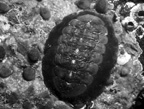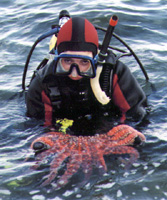Having a Ball
by
Philip Lambert
The White-plumed Anemone (Metridium
senile)
was photographed on the reef balls, March 2, 1997.
[credit]
PHIL LAMBERT
 In the beginning the sphere was void, but it had form.
Visitors soon arrived from surrounding space. First the aliens with 24 legs
investigated the virgin surface, followed by creatures with stalked eyes.
Ten-legged intruders quickly colonized the dark spaces inside the sphere,
awaiting the arrival of other unsuspecting visitors. Within a few months, spores
of a fuzzy red plant colonized the surface and began to germinate.
In the beginning the sphere was void, but it had form.
Visitors soon arrived from surrounding space. First the aliens with 24 legs
investigated the virgin surface, followed by creatures with stalked eyes.
Ten-legged intruders quickly colonized the dark spaces inside the sphere,
awaiting the arrival of other unsuspecting visitors. Within a few months, spores
of a fuzzy red plant colonized the surface and began to germinate.
Things were going according to plan.
Lowering a reef ball into place,
November, 1996.
[credit] Brenda Harfield
 "The beginning" was November, 1996; "the sphere," one of
270 hollow concrete balls that each weighed 200-340 kg (445 - 755 lb). "The
place," a new fishing pier recently erected at the foot of Bevan Street. The
Town of Sidney’s Economic Development Committee wanted a spot for people to
fish, scuba dive, catch crabs and shrimp or simply contemplate the ocean. The
seabed by the pier consisted of sand with few places for fish or crabs to hide.
To create a three-dimensional habitat suitable for fish and other marine life,
the planners decided to install an artificial reef. The Reef Ball Development
Group of Doraville, Georgia, USA agreed to donate the molds for the reef balls
providing that the arrival of new life was documented scientifically.
"The beginning" was November, 1996; "the sphere," one of
270 hollow concrete balls that each weighed 200-340 kg (445 - 755 lb). "The
place," a new fishing pier recently erected at the foot of Bevan Street. The
Town of Sidney’s Economic Development Committee wanted a spot for people to
fish, scuba dive, catch crabs and shrimp or simply contemplate the ocean. The
seabed by the pier consisted of sand with few places for fish or crabs to hide.
To create a three-dimensional habitat suitable for fish and other marine life,
the planners decided to install an artificial reef. The Reef Ball Development
Group of Doraville, Georgia, USA agreed to donate the molds for the reef balls
providing that the arrival of new life was documented scientifically.
In September 1996, the planners asked the Department of Fisheries and Oceans (DFO) at the Institute of Ocean Sciences in Sidney, BC to develop a procedure for monitoring the marine life. The project became known as SPARS which stands for Sidney Pier Artificial Reef Science. Staff at the Royal BC Museum were asked to help develop a species list and provide training in species identification. The DFO and their staff devised the survey procedure and enlisted the Professional Association of Diving Instructors (PADI) to supply a pool of volunteers. Diving experience was essential so that full attention could be paid to the surveying.
 I first dove on the reef balls in March, 1997 – about
four months after they had been laid – to record what species had arrived. The
24-legged Sunflower Star, the stalk-eyed Coon-Striped Shrimp and ten-legged Red
Rock Crabs already stood guard in the large circular holes or occupied the dark
spaces inside.
I first dove on the reef balls in March, 1997 – about
four months after they had been laid – to record what species had arrived. The
24-legged Sunflower Star, the stalk-eyed Coon-Striped Shrimp and ten-legged Red
Rock Crabs already stood guard in the large circular holes or occupied the dark
spaces inside.
The Sea Lemon (Anisodoris nobilis) (above) and
White Line Chiton (Tonicella insignis) (below), live
on a nearby natural
reef and are expected to inhabit the
reef balls eventually.
 The next job was to create a checklist of animals and
plants likely to colonize the balls in the coming months that were distinct
enough to be identified in the field with limited training. A nearby natural
reef provided a source for the list with 31 species of fish, 56 invertebrates
and 17 seaweeds.
The next job was to create a checklist of animals and
plants likely to colonize the balls in the coming months that were distinct
enough to be identified in the field with limited training. A nearby natural
reef provided a source for the list with 31 species of fish, 56 invertebrates
and 17 seaweeds.
After the initial tests and training sessions, the official surveys began in
May, 1997. "Scientists have first peek at artificial reef newcomers" read the
headline of one press release.
Diver displays a Sunflower Star
(Pycnopodia
helianthoides).
 Every two weeks a subgroup of our 20 volunteers have
been surveying the reef balls. They follow a strict protocol. They dive at slack
tide, not only to make the task easier but to reduce variations in sightings due
to current speed. Armed with a species list on waterproof paper, the divers
write down how many of each species they observe within a fixed time. For
example, the observer swims along the line of reef balls counting "swimming
fish" for 10 minutes. The strict time limit ensures that the diver uses equal
effort each time so that results are comparable with previous surveys. Other
categories are slow-moving and fast-moving invertebrates, bottom-dwelling fish
and seaweeds. The DFO then collects and compiles the data. This project is also
a pilot study on using volunteers to do underwater surveys, with plans to
publish the procedures and results, possibly as a Reef Keeper’s Guide that could
be used by other groups interested in surveying underwater sites along our
coast.
Every two weeks a subgroup of our 20 volunteers have
been surveying the reef balls. They follow a strict protocol. They dive at slack
tide, not only to make the task easier but to reduce variations in sightings due
to current speed. Armed with a species list on waterproof paper, the divers
write down how many of each species they observe within a fixed time. For
example, the observer swims along the line of reef balls counting "swimming
fish" for 10 minutes. The strict time limit ensures that the diver uses equal
effort each time so that results are comparable with previous surveys. Other
categories are slow-moving and fast-moving invertebrates, bottom-dwelling fish
and seaweeds. The DFO then collects and compiles the data. This project is also
a pilot study on using volunteers to do underwater surveys, with plans to
publish the procedures and results, possibly as a Reef Keeper’s Guide that could
be used by other groups interested in surveying underwater sites along our
coast.
So far, we have seen an upward trend in the number of species, from six to 35. Counts fluctuate as mobile animals like fish come and go and water visibility varies. DFO has also surveyed the site with an instrument that paints a three-dimensional picture of the reef balls sitting on the seabed. A meter anchored at the end of the reef continually records the speed and direction of the current. Between April 18 and June 4, 1997, the water temperature ranged from 8° to 12°C and currents from zero to almost one knot.
The Alabaster Nudibranch (Dirona
albolineata)
was photographed on the reef balls, March 2,
1997.
[credit] PHIL LAMBERT
 With the reef’s first anniversary, the sequence of its
colonization is emerging. Early in the season, animals were the main newcomers.
By late March, red filamentous algae made an appearance, covering the upper
surface of each ball with red fuzz. Within a matter of weeks the spores of brown
kelps found surfaces to grow on. With increasing daylight and nutrients, they
multiplied. These seaweeds now dominate the reef balls and have created a
habitat where gunnels and small sculpins can hide. Juvenile rockfish have
colonized the interior spaces and over the next few months, grew in size and
number. Barnacles arrived in vast numbers and glued themselves to the concrete
surfaces. As daylight dwindles, the algae are dying back and will be removed by
winter storms.
With the reef’s first anniversary, the sequence of its
colonization is emerging. Early in the season, animals were the main newcomers.
By late March, red filamentous algae made an appearance, covering the upper
surface of each ball with red fuzz. Within a matter of weeks the spores of brown
kelps found surfaces to grow on. With increasing daylight and nutrients, they
multiplied. These seaweeds now dominate the reef balls and have created a
habitat where gunnels and small sculpins can hide. Juvenile rockfish have
colonized the interior spaces and over the next few months, grew in size and
number. Barnacles arrived in vast numbers and glued themselves to the concrete
surfaces. As daylight dwindles, the algae are dying back and will be removed by
winter storms.
We expect more changes to come as other animals and plants replace or grow over the early colonizers. So stay tuned for the results as other aliens arrive from space and fill the once-void spheres with a myriad of new forms.
Many people have been involved in this project but, in particular, I would like to acknowledge the following: Kevin Conley, Jim Cosgrove, Gordon Green, Nick Panter, Brian Smiley and thirty-one keen volunteers whose enthusiasm and interest has made this project possible.
Phil Lambert is Curator of Invertebrates at the RBCM.